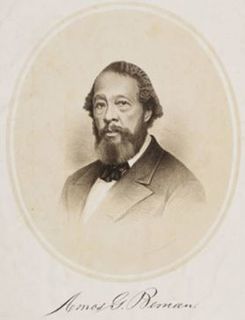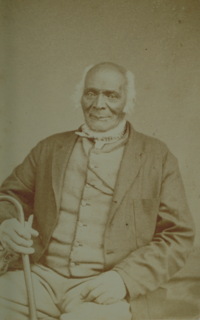Related Research Articles
Amos Noë Freeman (1809—1893) was an African-American abolitionist, Presbyterian minister, and educator. He was the first full-time minister of Abyssinian Congregational Church in Portland, Maine, where he led a station on the Underground Railroad, and served for decades at Siloam Presbyterian Church in Brooklyn, New York.

Willbur Fisk was a prominent American Methodist minister, educator and theologian. He was the first President of Wesleyan University.

Prudence Crandall was an American schoolteacher and activist. She ran the first school for black girls in the United States, located in Canterbury, Connecticut.

Thomas Sims was an African American who escaped from slavery in Georgia and fled to Boston, Massachusetts, in 1851. He was arrested the same year under the Fugitive Slave Act of 1850, had a court hearing, and was forced to return to enslavement. A second escape brought him back to Boston in 1863, where he was later appointed to a position in the U.S. Department of Justice in 1877. Sims was one of the first slaves to be forcibly returned from Boston under the Fugitive Slave Act of 1850. The failure to stop his case from progressing was a significant blow to the abolitionists, as it showed the extent of the power and influence which slavery had on American society and politics. The case was one of many events leading to the American Civil War.

Joseph Henry Lumpkin was a slave owner and the first chief justice of the Supreme Court of the U.S. state of Georgia.

David Ruggles was an African-American abolitionist in New York who resisted slavery by his participation in a Committee of Vigilance and the Underground Railroad to help fugitive slaves reach free states. He was a printer in New York City during the 1830s, who also wrote numerous articles, and "was the prototype for black activist journalists of his time." He claimed to have led more than 600 fugitive slaves to freedom in the North, including Frederick Douglass, who became a friend and fellow activist. Ruggles opened the first African-American bookstore in 1834.

Rev. Joshua Leavitt was an American Congregationalist minister and former lawyer who became a prominent writer, editor and publisher of abolitionist literature. He was also a spokesman for the Liberty Party and a prominent campaigner for cheap postage. Leavitt served as editor of The Emancipator, The New York Independent, The New York Evangelist, and other periodicals. He was the first secretary of the American Temperance Society and co-founder of the New York City Anti-Slavery Society.
Thomas James (1804–1891) had been a slave who became an African Methodist Episcopal Zion minister, abolitionist, administrator and author. He was active in New York and Massachusetts with abolitionists, and served with the American Missionary Association and the Union Army during the American Civil War to supervise the contraband camp in Louisville, Kentucky. After the war, he held national offices in the AME Church and was a missionary to black churches in Ohio. While in Massachusetts, he challenged the railroad's custom of forcing blacks into second-class carriages and won a reversal of the rule in the State Supreme Court. He wrote a short memoir published in 1886.

Charles Bennett Ray was a prominent African-American minister and abolitionist who owned and edited of the weekly newspaper The Colored American. Born in Massachusetts, he had most of his career and life in New York City.

The Oneida Institute was a short-lived (1827–1843) but highly influential school that was a national leader in the emerging abolitionist movement. It was the most radical school in the country, the first at which black men were just as welcome as whites. "Oneida was the seed of Lane Theological Seminary, Western Reserve College, Oberlin and Knox colleges."
Hosea Easton (1798–1837) was an American Congregationalist and Methodist minister, abolitionist activist, and author. He was one of the leaders of the convention movement in New England.

The exact date of the first African slaves in Connecticut is unknown, but the narrative of Venture Smith provides some information about the life of northern slavery in Connecticut. Another early confirmed account of slavery in the English colony came in 1638 when several native prisoners were taken during the Pequot War were exchanged in the West Indies for African slaves. Such exchanges become common in subsequent conflicts.

The Temperance movement in the United States is a movement to curb the consumption of alcohol. It had a large influence on American politics and American society in the nineteenth and twentieth centuries, culminating in the prohibition of alcohol, through the Eighteenth Amendment to the United States Constitution, from 1920 to 1933. There is some disagreement whether the policies were a 'failure' or whether they triggered an increase organized crime, though that remains a commonly held belief. Several years after Prohibition policies were lifted, alcohol use remained significantly lower but eventually rose to pre-prohibition levels. Crimes that were associated with excessive drinking such as domestic abuse also saw a sharp decline during Prohibition. Alcohol consumption is much lower than it was in early 1900's.. Today, there are organizations that continue to promote the cause of temperance. The World Health Organization has noted that out of social problems created by the harmful use of alcohol, "crime and violence related to alcohol consumption" are likely the most significant issue.

Amos Gerry Beman (1812-1872) was a 19th-century African American pastor and social activist from Connecticut. He was a prominent African American abolitionist.

In the United States, abolitionism, the movement that sought to end slavery in the country, was active from the late colonial era until the American Civil War, the end of which brought about the abolition of American slavery through the Thirteenth Amendment to the United States Constitution.
African Americans are the largest ethnic group in the state of Tennessee, making up 17% of the state's population in 2010. African Americans arrived in the region prior to statehood. They lived both as slaves and as free citizens with restricted rights up to the Civil War.

Hester C. Jeffrey, néeWhitehurst was an African-American activist, suffragist, and community organizer in Rochester NY and New York City. She is known for her involvement with the Political Equality Club, the Women's Christian Temperance Union, and the National Association of Colored Women's Clubs.

Amos Dresser was an abolitionist and pacifist minister, one of the founders of Olivet College. His name was well known in the Antebellum period because of a well-publicized incident: in 1835 he was arrested, tried, convicted, and publicly whipped in Nashville, Tennessee, for the crime of possession of abolitionist publications. The incident was widely reported and became well known. Dresser spoke of it frequently.
The National Convention of Colored Citizens was held August 15–19, 1843 at the Park Presbyterian Church in Buffalo, New York. Similar to previous colored conventions, the convention of 1843 was an assembly for African American citizens to discuss the organized efforts of the anti-slavery movement. The convention included individuals and delegates from various states and cities. Henry Garnet and Samuel Davis delivered key speeches. Delegates deliberated courses of action and voted upon resolutions to further anti-slavery efforts and to help African Americans.

James Mars was an American slave narrative author and political activist. Born into slavery in Canaan, Connecticut, he gained his freedom in 1811. In 1864, he published his memoir A Life of James Mars, a Slave Born and Sold in Connecticut, Written by Himself—a notable example of the slave narrative genre. His grave is a stop on the Connecticut Freedom Trail. In 2021, Governor Ned Lamont declared May 1 to be James Mars Day in Connecticut.
References
- ↑ Housley, Kathleen (1992). "Yours for the Oppressed': The Life of Jehiel C. Beman". The Journal of Negro History. 77 (1): 17–29. doi:10.2307/3031524. ISSN 0022-2992.
- ↑ Welch, Vicki S. (2006). And They Were Related, Too: A Study of Eleven Generations of One American Family!.
- ↑ US Census: Year: 1830; Census Place: Middletown, Middlesex, Connecticut; Series: M19; Roll: 8; Page: 17; Family History Library Film: 0002801
- ↑ Connecticut, U.S., Hale Collection of Cemetery Inscriptions and Newspaper Notices, 1629-1934, Washington Street Cemetery, 711-12, page 594
- ↑ Rhode Island, U.S., Vital Extracts, 1636-1899
- ↑ James, Jennifer Lee (1997). "Jehiel C. Beman: A Leader of the Northern Free Black Community". The Journal of Negro History. 82 (1): 133–157. doi:10.2307/2717500. ISSN 0022-2992.
- ↑ Warner, Robert (1937). "Amos Gerry Beman-1812-1874, a Memoir on a Forgotten Leader". The Journal of Negro History. 22 (2): 200–221. doi:10.2307/2714429.
- ↑ US Census Year: 1840; Census Place: Boston Ward 5, Suffolk, Massachusetts; Roll: 197; Page: 303; Family History Library Film: 0014681
- ↑ Housley, Kathleen (1992). "Yours for the Oppressed': The Life of Jehiel C. Beman". The Journal of Negro History. 77 (1): 26. doi:10.2307/3031524. ISSN 0022-2992.
- ↑ "Deaths". Hartford Courant. Hartford, Connecticut. 24 October 1856. p. 2.
- ↑ Connecticut, U.S., Hale Collection of Cemetery Inscriptions and Newspaper Notices, 1629-1934, filmstrip image #426 of 640
- ↑ "Died". The Liberator. 7 Jan 1859. p. 3.
- ↑ Day, Cassandra (2021). "Middletown ceremony celebrates new Beman Middle School". The Middletown Press.